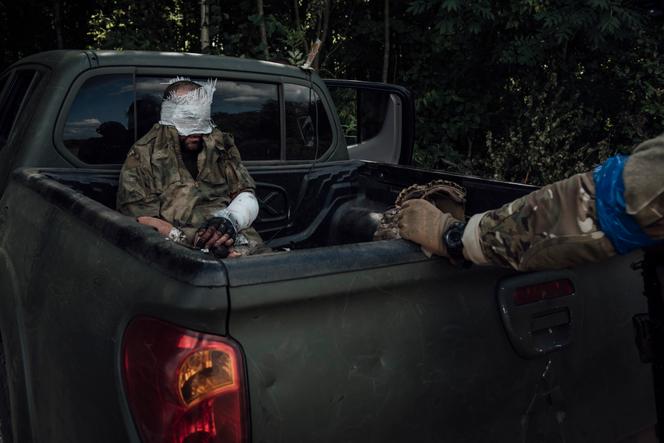


At the entrance to the Ukrainian town of Sumy, some 30 kilometers from Russia, civilians and soldiers were filling up at the gas station, while others sipped soft drinks and coffee. On Thursday, August 15, no one seemed to be paying much attention to the group of soldiers leaning against a pickup truck parked nearby. Having just come back from a few hours' mission in Russia, they didn't return empty-handed. They brought back a soldier from the enemy camp – a prisoner of war.
The 36-year-old man, wounded and concealed by the sides of the truck bed, lay before indifferent onlookers, his uniform torn over bandages on his leg and arms, his hands bound and his face masked. "Papaye," a Ukrainian soldier (who preferred not to reveal his name or unit) claimed that the prisoner had fought on the Kherson front, in southern Ukraine, before being redeployed on July 22 to Russia's Kursk region, where Ukrainian forces launched an unexpected incursion at dawn on August 6.
Although this offensive, planned in utmost secrecy for months, entails high risks for the Ukrainian army, given its difficulties on the Donbas front further south, it is nonetheless a setback for the Kremlin. The 245-kilometer-long border region was only weakly defended on the Russian side, and largely manned by conscripts from the ranks of the border guards, part of the FSB, the Russian security services.
Eleven days after the start of their offensive, Ukrainian forces now claim to control 1,150 square kilometers and have even continued to advance. On Friday evening, the army's commander-in-chief, Oleksandr Syrski, stated that "the troops continue to fight. They have made advances of 1 to 3 kilometers towards the enemy."
Rumors of an unprecedented number of Russians surrendering as prisoners of war quickly circulated on social media. While neither side has disclosed the number of captured soldiers, photos and videos shared on the Ukrainian side seem to suggest a higher count on Kyiv's end. Military personnel interviewed by Le Monde in the Sumy region referred to "hundreds" of Russian prisoners. "I stopped counting when we got to a hundred," said "Papaye." "Many of them don't know where to go, they wander the forests and fields, some having abandoned their uniforms, which are left lying on the ground," he said, before getting back behind the wheel to transport the prisoner he held to a secret detention center on Ukrainian soil.
While Kyiv's objective in launching this offensive in the Kursk region is to influence any negotiations with Moscow, the capture of numerous Russian prisoners of war is regularly highlighted by the authorities. On August 13, President Volodymyr Zelensky himself spoke of "hundreds" of Russian prisoners. He has repeatedly praised these captures for helping to "replenish" a "prisoner exchange fund." Both sides already hold thousands of prisoners. In June, Russian President Vladimir Putin mentioned approximately 6,500 Ukrainian soldiers in captivity compared to 1,300 Russians held by Ukraine.
You have 52.51% of this article left to read. The rest is for subscribers only.
